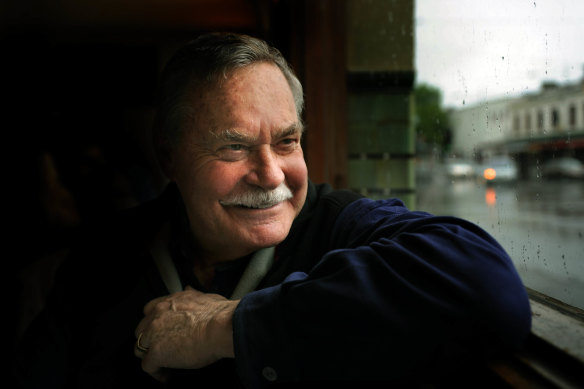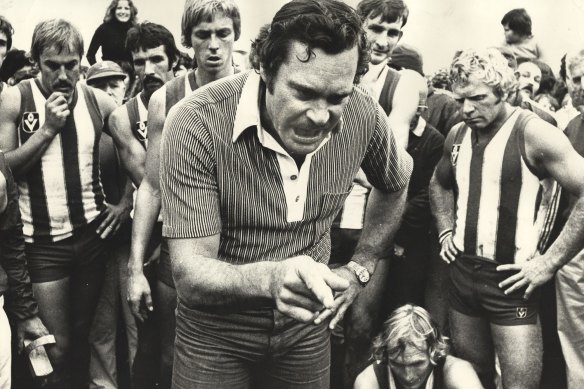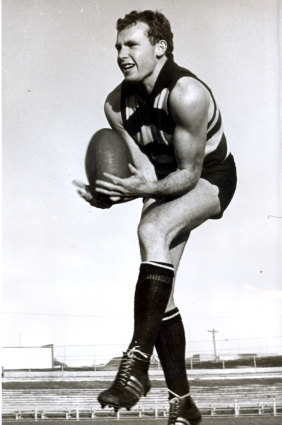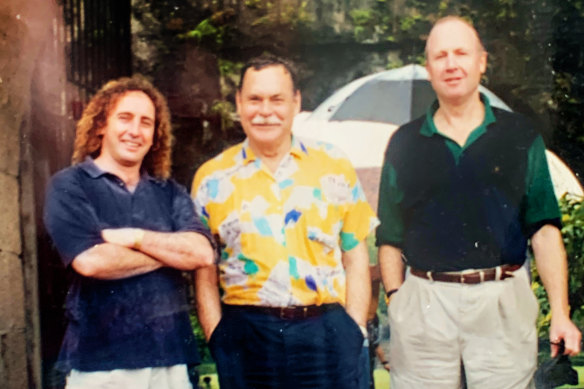Ron Barassi plotted my demise, but he was my hero
Save articles for later
Add articles to your saved list and come back to them any time.
Geelong in the 1950s and ’60s was much smaller than it is today and, without being unfair, it was bland and colourless. Much of the world was recovering from the Second World War. Born in 1946, I was one of the original “Baby Boomers”.
For many of those years the Cats had good football teams and won three VFL flags. Melbourne had great sides.
As a kid sitting on my father’s shoulders or standing on a fruit box at Kardinia Park, I cheered for captain Fred Flanagan and his Geelong teams. They were my local heroes. I would recite the players’ numbers off the top of my head. But they were mere mortals in my football psyche when measured against the No.31 for Melbourne. Ron Barassi.
AFL Legend Ron Barassi in 2010.Credit: Mal Fairclough
Most memories of him were black and white. Through newspaper images and later television, he was everywhere. On the ground or on the air, it was Barassi.
In 1965, the bombshell of Barassi moving from Melbourne to Carlton as their playing coach rang through the football world. In the same year, I’d grown up and become a Cat myself. My second game for Geelong was at Princes Park, the home of the Blues – and Barassi’s new home.
It was his first home game and 34,946 people swarmed the ground. Robert Menzies was probably there in his Bentley.
I was full-forward for Geelong, matched up on Carlton full-back, Graeme Anderson. Alongside me for much of the game was Barassi. He went to defence following a clash with my captain, Polly Farmer.
State memorial service for Ron Barassi AM
- 11am Friday, MCG
- Tickets are free, via Ticketek
- Gates open 10am, (enter gate 2)
- Parking via gate 3 from 9.30 am
- Service will be shown live from 10.30am on Channel 7 and 7plus
- Livestream available at www.vic.gov.au/ron-barassi
When “Barass” rolled me into the boundary fence I almost wanted to say sorry for being in his way, such was my awe. (Note, I’m now calling him Barass – as in, my mate Barass). The Cats won by six points with Farmer kicking five goals and me, three. I must have played very close to the big sticks.
The 10 years of my VFL career (1965-75) had begun with a healthy mixture of success, some flat spots, and a year travelling around Europe in a Bedford van. In various guises, Barass loomed over it. Can you imagine him taking a year off? He was the ultimate professional in a non-professional era.
As a player, then Carlton and North Melbourne coach and then a commentator, his was a tour de force. He and Ted Whitten were both called “Mr Football”, but ultimately Ron Barassi wore the crown.
He coached North Melbourne the day I played in the 1974 premiership for the Tigers. Sadly, he was one of North Melbourne’s henchmen who had poached my Geelong teammate, Doug Wade, the previous year.
Ron Barassi giving his North Melbourne team a serve.Credit: The Age Archives
He coached North Melbourne on preliminary final day the next year, moving Paul Feltham on to me in the second half. Feltham got away from me (too fast, too small, too smart), and snapped a couple of goals. I was benched. I remember trudging along the outer flank of VFL Park, knowing I had played my last game. Barass had plotted my demise. He still loomed large in my life.
Whether it was at sportsmen’s nights, Channel Seven’s World of Sport or the Tony Charlton Footy Show on Channel Nine, Barass was in a small cavalcade of regular stars. I was one of the “irregulars”.
Ultimately, I joined the ABC as a commentator/panellist and analyst in 1979. One of the highlights was when Barass and Leigh Matthews joined us on the panel of the Friday Night Footy Show. I finally had Barass on my team – and “Lethal Leigh” as well. What a joy.
Gareth Andrews in his Geelong days.Credit: The Age
Most of the joy came from the mix of ABC sports journalists (Lane, Morphett, Thomson, Booth) and footy greats. Barass’ presence was a highlight, of course. The 10pm Friday Night Footy Show was pre-recorded after lunch, which created a few problems. Notably, if there was major football breaking news after the recordings, the tape was already “in the can”. Too late.
Weekly we arrived at a small Italian restaurant near the ABC’s Ripponlea studios. We bought our beverages from the liquor store next door.
We each thought we’d found the bottom shelf – say, $5 for a rough red – until Barass found the roughest red imaginable for $1.50 or $2.00 a bottle. He quaffed it with joy. By the time we headed down busy Glenhuntly Road to the studios, he would be chortling with chest bursting. He was literally running onto the field. He knew his subject.
In 1999 I was excited to be chosen to go to Manila as a guest of the Philippines/Australia Chamber of Commerce annual grand final event. Representing the AFL were Barass, ex-Hawthorn star John Platten and myself as players who had played in winning grand final teams.
From the moment I caught up with Barass at Melbourne Airport I realised how iconic he actually was. Just walking to the plane drew rubbernecking of the first order. Nothing changed when we arrived in Sydney. Australian rules was still trying to get a foothold in this rugby-crazy city, but they knew Barass.
Gareth Andrews (right), with John Platten and Barassi in Manila.
The main event of the weekend was the AFL grand final, played live on a huge screen to an audience of about 1000 Aussies and Filipinos (and Filipinas) in a Manila ballroom. The hosts knew nothing about the game but were mesmerised by this man.
Barassi never sought accolades, but he got them anyway. It was a rollicking three days. We were the three amigos, and he was our leader.
His was a face constructed to grimace as well as to smile. He was quirky, quick of wit and fun to be with, but his humanity and care for others were his greatest gifts. Actually, it was our greatest gift. He was genuinely interested and gave 100 per cent of his time to anyone he engaged with. There was an aura around Barass.
In 2010 I joined former Hawthorn star and my mate Ray Wilson in South Africa for the soccer World Cup. Australia were playing Germany in Durban, a mighty task. The vuvuzelas were revving up before the game when Ray, beneath the cacophony, directed me to our right:there was Barassi, dressed in his Australian fan attire, alongside former state Labor Party minister Steve Crabb, furiously willing the Socceroos forward (to no avail). Barass was the man I was least expecting to see at this time and in this place. He was always inquisitive.
Catching up at half-time, Barass explained that another friend, Bill Shannon, was joining him in South Africa.
Bill, a Melbourne marketing and advertising guru, became the constant over the next part of my Barass journey. He had befriended Barass years earlier and, along with a group of older mates including John Bertrand, they had turned into adventurers, journeying together through Mongolia, Cuba and the Kokoda Trail in PNG. They were my sort of people.
Barass was always my sort of person. More recently, I spent time with him along with Bill Shannon and Barass’ wife, Cherryl. Over coffee in Albert Park, the conversations were always broad and stimulating. Despite the decline in Barass’ health, he didn’t let much through to the keeper.
One of the last times Bill and I met Barass and Cherryl was on a lovely autumn evening with packed tables outside adjoining cafés, bars, and restaurants. As he and Cherryl were leaving, Barass stopped to talk at every table.
It made me think of the piece by Ian Turner, academic author of the 1970s, in which he coined the notion of a “Barassi Line”; an imaginary divide between the Australian rules football-centric south and the rugby-centred north. It could just as easily have split the country into two tribes – those who knew Barassi, and those who did not. It seemed everyone knew him that night.
Keep up to date with the best AFL coverage in the country. Sign up for the Real Footy newsletter.
Most Viewed in Sport
From our partners
Source: Read Full Article



